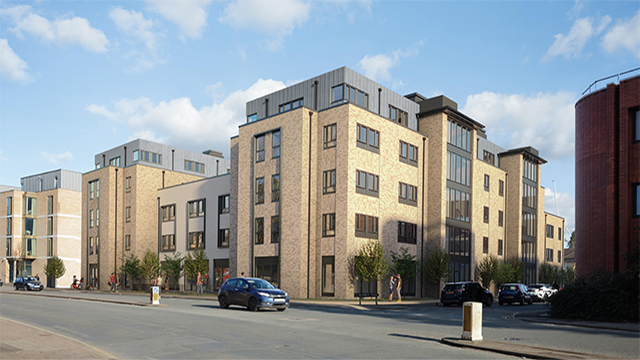Sustainability: Is the price right?
Let’s face it, green is last decade’s colour. Before the 2008 crash housebuilders could not paint themselves green fast enough. Then along came the recession and fancy extras were off the agenda.
Political enthusiasm eventually dwindled, too – what mattered was volume, not colour. Today the Code for Sustainable Homes is just a memory, incinerated in 2015 as part of a bonfire of housing red tape.
So if the stick of government policy has become kindling, how about the carrot of premium prices and consumer enthusiasm? Are house buyers and renters prepared to pay a higher price for a more sustainable home?
[caption id="attachment_864028" align="alignright" width="200"] Photo by REX/Shutterstock[/caption]
Let’s face it, green is last decade’s colour. Before the 2008 crash housebuilders could not paint themselves green fast enough. Then along came the recession and fancy extras were off the agenda.
Political enthusiasm eventually dwindled, too – what mattered was volume, not colour. Today the Code for Sustainable Homes is just a memory, incinerated in 2015 as part of a bonfire of housing red tape.
So if the stick of government policy has become kindling, how about the carrot of premium prices and consumer enthusiasm? Are house buyers and renters prepared to pay a higher price for a more sustainable home?
The Building Research Establishment says yes, definitely. Its surveys show buyers saying they might pay up to £750 extra (for a £300,000 property) if it had the right green badging.
Others aren’t so sure: virtue-signalling in a survey is easy. Paying real money, when location and price still dominate, is quite another. Evidence that people do, in fact, pay more when given the choice is scant.
Developers such as Grosvenor and Lendlease want to do the right thing – morally right and appealing to consumers – but what is that, exactly? Lendlease mourn the loss of the Code, which provided some clear industry standards to meet or exceed, and Grosvenor has been experimenting with BREEAM ratings for residential.
Meanwhile the Building Research Establishment is launching a new badge, the Home Quality Mark. So far just 4,000 new homes are making their way through the system.
According to Paula Higgins, chief executive of the Home Owners Alliance, if housebuilders are hoping most customers will pay a premium, they are nursing a delusion. While an energy-efficient home is popular – 51% rate it as the main advantage of a new home – that doesn’t mean they expect to pay extra for it.
“Yes, everyone rates energy efficiency very highly – lower running costs for a home is one of the biggest appeals to buyers. But most wouldn’t pay a premium price, and they shouldn’t have to,” she says, adding that in any case much mass-housebuilding is getting shoddier, not more efficient, thanks to poor or non-existent building control inspections.
There is no evidence yet for a value shift for green houses and I see no evidence – apart from a small subset of buyers – that they take pride in having a house badged as particularly green.”
“We get cases of buyers told their houses will be 40% cheaper to heat, and in fact there is not enough insulation,” she says.
Nick Whitten, associate director in the residential research team at JLL, says the problem is that green standards have morphed into good standards. Consumers long ago stopped regarding energy efficiency as a new home extra.
“The classic new-build price premium of 15-20% now simply includes green things in consumers’ minds – it is what they expect from a new house, along with the shiny new smell. Green features have become standard.
“There is no evidence yet for a value shift for green houses and I see no evidence – apart from a small subset of buyers – that they take pride in having a house badged as particularly green.”
However, Whitten says the baby steps now being taken towards green lending could change that – eventually.
Regional housebuilders have no illusions. Mike Coulter, managing director at Oldham-bassed Grasscroft, says: “It is right and proper that we develop and build sustainable homes, however, in most circumstances there is no added value on the bottom line in including new technology.
“The only way, therefore, to make house building more intelligent is through regulation.”
However, in London it’s a different story says Lendlease’s Paul King, managing director for sustainability. “Customers should expect buildings to be more energy efficient and sustainable, but it is wrong to say all housebuilders are the same. Look at the rankings, and there’s a big difference between the builders at the top and those at the bottom,” he says.
Savvy buyers are increasingly likely to notice the difference, King hints. But the benefit for housebuilders may be hard to reduce to a simple premium price calculation, he says.
“You can’t isolate the environmental elements and say we’re getting a price for that. It’s just that a better quality home gets a better price,” he says.
One day soon – we’ve heard that a few times before. The green housing business has been dogged by it, and still no sign of a premium price. Maybe this time it will turn out not to be wishful thinking?
The Ebury Street experiment
Ebury Street, SW1, is the scene of the latest green building experiment.
Grosvenor has unveiled what it claims is the UK’s most sustainable period rental properties, after winning a BREEAM outstanding rating.
This is the first time BREEAM has been used in this way in the residential sector. Ebury was developed under BREEAM Refurbishment (domestic) – a scheme specifically for housing.
A 360º view of the garden at Ebury Street
The 4,200 sq ft former hotel building in Belgravia is designed to reduce carbon emissions by more than 75%. Victoria Herring, director of refurbishment and retrofit for Grosvenor in London, says being green helps with marketing, and in meeting Grosvenor’s central sustainability targets, but she hasn’t seen – and doesn’t expect – a premium price.
The big prize is controlling landlord costs. Lower longer-term maintenance and energy costs – and reductions in the size of the sharp refurbishment spikes that come on a seven to 10-year cycle. “We’re looking at maybe halving the long-term care costs,” she explains.
“I would like to say things like that appeal to occupiers, but in most cases it is a nice to have, rather than a must have, so when we talk sustainability to occupiers we talk about sound insulation and better air quality, issues they really do care about.”
360º views of the kitchen, living room and entrance
Click here for more 360º images of the Ebury Street experiment
Follow the money
Mortgage lenders, building industry experts, green energy groups and sustainability bodies have joined forces to launch research into how to link mortgages to green building standards – and it could help to inspire a green building price premium.
Chaired by Nationwide Building Society, the Lenders project is investigating the increased use of the Energy Performance Certificate (EPC), required on every home for sale.
The research will test the use of EPC data in estimating energy costs on individual homes and look at the potential to incorporate that estimate into the mortgage affordability calculation. In turn, this may help encourage buyers towards homes with lower energy bills, and increase their willingness to invest in improving energy efficiency.
They could go further: if lenders were prepared to allow larger loans to buyers of green buildings it could incentivise buyers – and builders.
JLL’s Nick Whitten says: “If the multipliers on mortgage loans are higher for green buildings, that could really alter consumer behaviour.”
More than just hot air?
Could improved internal air quality be the bait homebuyers need to pay more for green housing?
Concern about internal air quality is rising fast. Studies show toxic nanoparticles from air pollution are appearing in human brains, while phone apps like BreezoMeter and uBreathe are making it easier to measure air quality in the home. Dyson launched a new £500 air purifier last month.
Lendlease’s Paul King says: “There’s huge interest in this. It’s part of the huge synergies we’re seeing between the green agenda and the health and wellbeing agenda. That means things like using low-emissions paints and adding air filters to ventilation. I wouldn’t underestimate the importance of issues like air quality – occupiers will hold developers to account for it.”
Claire Racine, associate director at JLL’s Upstream Sustainability business, agrees. “Housebuilders will find buyers’ interest in health will feed into issues of sustainability. Air quality is going to be a real driver in the future because it is so immediate – you just took another breath, there it is,” she says.
It will mean new thinking on ventilation and materials, she warns.











